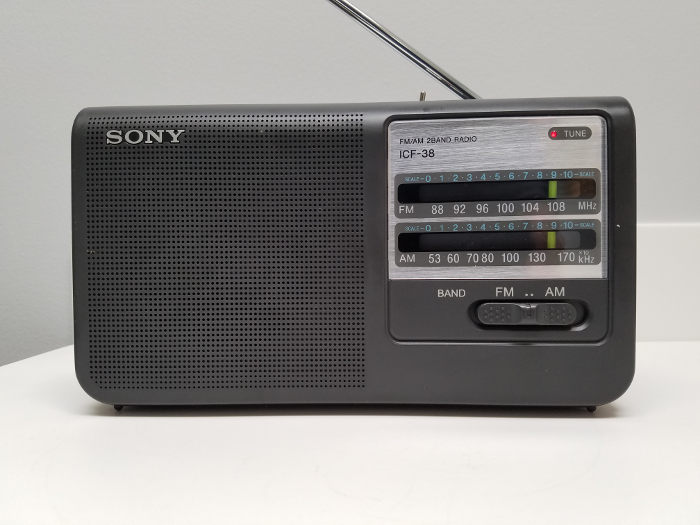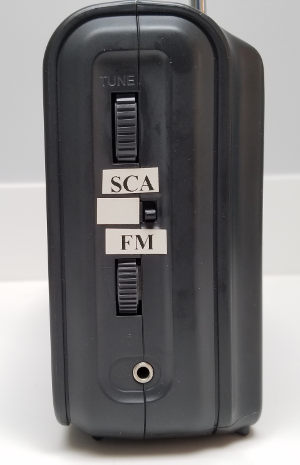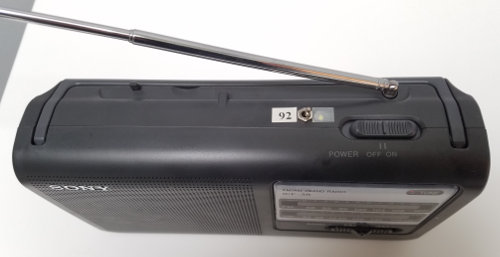Radios I Have Known
Sony ICF-38 AM/FM radio (modified for SCA reception)

The Sony ICF-38 is about as modest as you can get: AM and FM reception, a slide-rule tuning dial, another large thumbwheel as a volume control, a battery compartment for 3 "AA" batteries along with a power cord for AC power, and a carrying handle. The color is gray. This is a radio that doesn't call attention to itself. It seems pleasant and reliable.
Because of the radio's size and its built-in capability to run on AC power, I've classified it as a table radio even though it is portable.
My research indicates that the radio sold for around $25 until it was discontinued around 2013. Another model, the ICF-36, was similar, adding reception of analog TV audio signals plus National Weather Service radio broadcasts between 162.40 and 162.55 MHz. Analog TV audio is no longer relevant, but Weather Service reception is still useful.
The ICF-38's 3 1/2" speaker easily produces room-filling, undistorted sound. There is a headphone jack but, unusually for a radio that's this recent, it's a monaural jack. To use stereo headphones, far more common now, an adapter is needed.
The stock version of this radio (and the ICF-36) has a high-low tone switch. But this radio has been modified!

The high-low tone switch has been repurposed to enable the reception of additional radio signals. The sticker that says "SCA" tells the story.
I bought this radio off eBay in order to have a radio that could receive FM SCA (Subsidiary Communications Authorization) channels. SCA, also called SCS (or SCMO in Canada) is a method of adding audio signals to a standard FM signal. A special receiver must be used to pick up these signals. It's called multiplexing, and it's an old technique: Edwin Howard Armstrong, the inventor of FM radio, was experimenting with multiplexed signals on a regular FM signal before his death in 1954. FM stereo broadcasts also use a form of multiplexing.
During the 1950's many FM stations went off the air because relatively few people had FM receivers, limiting those stations' potential audience. The Federal Communications Commission approved the use of multiplexing in May 1955. The idea was for FM stations to lease their multiplexed channels for so-called "functional" programming such as background music. The company that leased the multiplexed channel would, in turn, lease specialized receivers to businesses or others who wished to receive the special broadcasts.
SCA was used mostly for background music services, such as Muzak, at first. In the 1980s, it was also used to provide various data services. Some stations also used an SCA subcarrier to assist in remote control of their transmitters. While not every FM station maintained SCA channels, enough did to create a small market for SCA-capable radios.

Eventually, a standard configuration for an FM signal with SCA would be for one channel centered on an FM subcarrier 67 kHz either side of the main signal, and another at 92 kHz. During the 1990s, for example, Muzak would often lease both subchannels from FM stations, running its traditional service on the 67 kHz subchannel and a more contemporary service on the 92 kHz subchannel.
On the modified Sony ICF-38, the added switch on the top of the radio allows either the 67 kHz subchannel or the 92 kHz channel to be selected. (The label for the 67 kHz side of the switch has fallen off.)
In the 2000s, SCA use dwindled considerably. First satellite services for background music, and then online connections, replaced many SCA services. Data transmission moved entirely online. A few ethnic broadcasters have remained. Using an SCA subchannel for music was always somewhat problematical: they were somewhat low-fidelity and sometimes varied in their support for simple noise-reduction schemes such as pre-emphasis. Moreover, an FM station's SCA subchannel has a somewhat smaller coverage area compared to the main FM channel of the same station.
In the San Francisco Bay Area, only KPFA maintains an SCA service: a Pacifica news service at 67 kHz and South Asian ethnic broadcasting at 92 kHz.
Because of the addition of an SCA decoder, it's possible that this radio had also been tweaked to improve its reception performance. In any event, this unit performs reasonably well on FM. There are hints of front-end overload at the edges of the FM dial, and the radio is only moderately selective, but it is sensitive. The FM antenna is the wrong length: 25 inches, five inches shy of where it should be. AM reception is adequate, but suffers from an odd background noise that sounds like low-grade burbling. On AM, it's best used for strong local signals. On FM, the ICF-38 manages fairly well with a crowded FM dial but occasionally a strong signal will swamp a nearby weaker signal.
The ICF-38 is a competent performer with pleasant sound, excellent ergonomics, and simple operation. It's too bad Sony still isn't making this model.